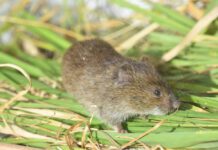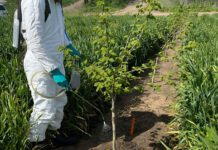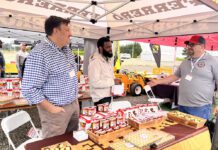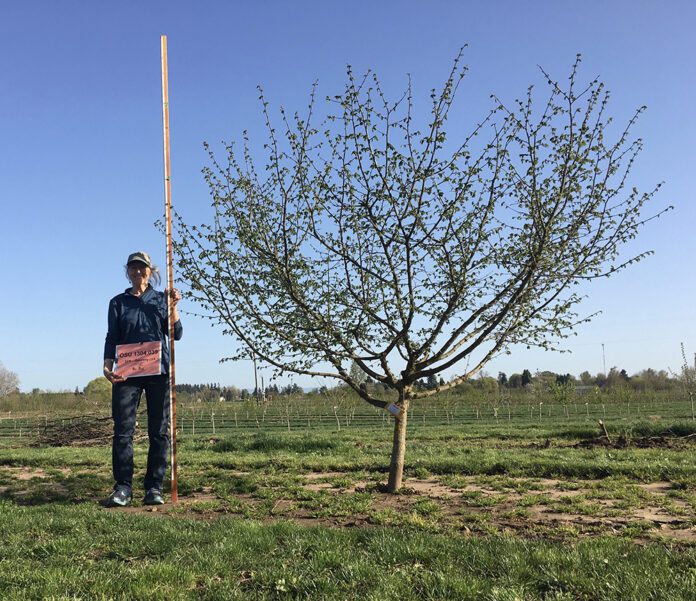
Hazelnut growers looking for a compact cultivar well-suited to high-density orchards have a new option in the Oregon State University (OSU) Hazelnut Breeding Program’s latest release, Thompson.
The release, the first for the breeding program since 2018, offers growers an opportunity to implement production methods associated with high-density orchards with minimal pruning, according to OSU Hazelnut Breeder Shawn Mehlenbacher.
“I’m excited about Thompson because it targets a different production system than the standard hazelnut production system,” Mehlenbacher said. “It opens up an opportunity that wasn’t there before. It targets people who are willing to take a chance and try something new. We have a lot of new people in our industry now, so it’s not just planting them 20 x 20 feet apart like we’ve done for 80 years. This is a new opportunity, and I think some people will jump on it.”
Grower Interest
Mehlenbacher said growers have approached him in recent years about releasing a compact cultivar for high-density planting. Thompson, with its low vigor and high-quality kernels, stood out among other selections with similar growth habits in the breeding program. In trials spanning 2017-20, the new cultivar outperformed the high-yielding cultivars Jefferson and McDonald in nut-yield efficiency, scoring the highest of all trial entries when factoring in tree size, a factor that bodes well for per-acre yields in high-density plantings. Nut weight of Thompson was similar to McDonald in the trials, according to an OSU report, while kernel weight was intermediate between McDonald and Wepster, two popular cultivars also released by the breeding program in the past 11 years.
Thompson produced a high percentage of good nuts in the trials and a low percentage of blanks, brown stain, poorly filled nuts, twins and kernels with black tips, according to the report.
“There may be some disappointment from the handlers in that they would like the percent kernel to be higher,” Mehlenbacher said. But the kernels the tree produces are of good quality.
Susceptibility to bacterial blight has not been quantified, but researchers saw no bacterial blight infection in two trials. Nevertheless, OSU is recommending applying copper to minimize damage from the Xanthomonas campestris pathogen, particularly in the first three years of the tree. The variety has shown good resistance to bud mite.
While not maturing as early as McDonald and PollyO, Thompson is still earlier than Barcelona, the industry standard, by four days. Also, Mehlenbacher pointed out, if growers harvest over the top, which doesn’t require waiting for nut drop, they could be harvesting in mid-September.
Recommended pollinizers for Thompson include Wepster, PollyO, Dorris and Yamhill.
Thompson held up well against Eastern Filbert Blight (EFB) in the trials, but that was before a new strain of EFB was discovered in the Willamette Valley, a strain that is able to overcome the single Gasaway gene resistance contained in Thompson as well as several other releases from the OSU Hazelnut Breeding Program.
“It’s unfortunate the EFB fungus has changed,” Mehlenbacher said, “but these things happen in agriculture.”
Changing Practices
When fully mature, Thompson trees are considerably smaller than Barcelona, and its trunk cross-sectional area, or TCA, is considerably less than Barcelona, coming in at 46.7% of an adjacent row of Barcelona trees in one trial. Comparatively, the TCA of Jefferson, McDonald and Wepster were between 70% and 80% of the Barcelona trees in that trial. Thompson trees can be planted 7 feet apart within a row, according to OSU literature, with row spacings of between 16 and 20 feet.
The tree’s compact growth habit should fit well with new production practices being used in the Willamette Valley, including fruiting-row designs and over-the-top harvesting with a converted blueberry harvester. A smaller tree is also easier to cover with fungicides, according to OSU Plant Pathologist Jay Pscheidt, which should help with EFB management if the new strain of the fungus were to infiltrate a Thompson orchard. And OSU Extension Orchard Specialist Nik Wiman noted it is easier to optimize other inputs as well in a high-density system.
“One thing I really like about high-density systems is they’re more efficient because you can concentrate your nutrient applications and your irrigation,” Wiman said. “You can manage the canopy easier with the sprays you have to put on.”
The spherical growth habit of Thompson also should help minimize tree losses from an ice or a snow storm. Arguably, however, the main benefit of planting Thompson in a high-density system is the improvement it brings in early returns.
“The problem with hazelnuts, like some other orchard crops, is they’re slow to mature and you really don’t start making any money back from your initial investment until you’re pretty deep into it,” Wiman said. “But by filling the space with more trees, you can have a much higher precocity and much higher early returns on the orchard.”
Growers in Europe have widely adopted high-density hazelnut orchard systems to considerable success, Wiman said. “Some of that came out of olive production, because olives are even slower maturing than hazelnuts, and they were looking for ways to get returns on investment a lot sooner for olive orchards, and they started applying some of the same principles to hazelnuts and having a lot of success.
“If you look at other orchard crops, such as apples, they’ve all gone toward higher density production,” he added.
Double-density planting, a system that involves removing half the trees once they begin to crowd out one another, is a practice growers have long used to improve early returns. But it is becoming less attractive as of late, Wiman said, in part because of changing cultural practices.
“In the economic models we have for double density, we like to see orchards get to 9 or 10 years before the trees have to be thinned,” Wiman said, “but almost no one is making it that long anymore. Trees are growing faster with our cultural practices and many people are reaching that stage where trees need to be cleaned out sooner than we used to.”
Wiman noted researchers will be planting Thompson trees at a rate of around 400 per acre in an experimental orchard they are starting this fall to try to quantify the advantage high-density offers in terms of early returns.
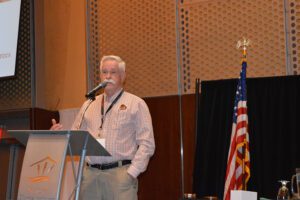
Tree Pedigree
Thompson, named after Maxine M. Thompson, who initiated the hazelnut breeding program at OSU in 1969, has a pedigree that includes germplasm from Italy, Spain, England and Turkey.
Its release last August marked the culmination of nearly 20 years of work as breeders made their first cross with Thompson in 2005. Typically, it takes 17 years from the first cross of a variety to a release date. In this case, the release was delayed because trees were not available until August.
Mehlenbacher noted North American Plants in Lafayette, Ore. has told him they have trees to sell if growers are interested.
As for what is ahead for the breeding program, Mehlenbacher said he expects the program to release a cultivar with resistance to the new strain of EFB in two to five years. “We have many selections in replicated yield trials whose resistance is different than Gasaway,” Mehlenbacher said. “It is hard to forecast which one or ones are worthy of release at this point. But there are a lot in the pipeline.”
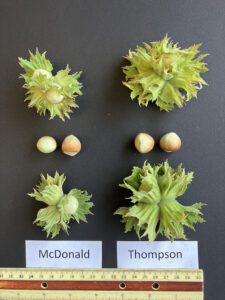
He added resistance to the new strain is the most important trait for the program as it advances lines at this point. “It is certainly high on our list of importance to hand a different resistance source to our growers,” he said.
He further noted the program has been working on finding different sources of resistance to EFB for more than two decades, though not as aggressively as it is doing so now. “I’ve been here since 1986, and I’ve been collecting material pretty much everywhere I can get my hands on it, and we test everything to see how it reacts to Eastern Filbert Blight inoculation or exposure. And then we get into the mapping with DNA markers to find out which chromosome carries the resistance. So, we’ve been doing it seriously since about the late 1990s,” he said. “But at this point, that has become more important.”







